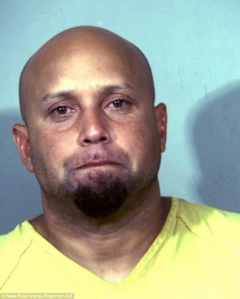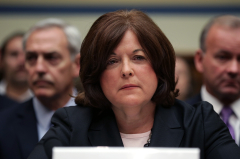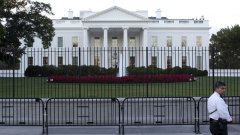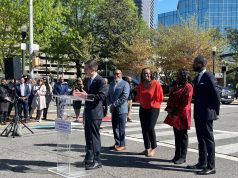


FROM WIRE AND STAFF REPORTS
The director of the U.S. Secret Service offered an apology on Tuesday for security lapses that allowed a knife-wielding intruder to get into the White House through an unlocked door, down a hallway and into the East Room.
‘It is clear that our security plan was not executed properly,’ Secret Service Director Julia Pierson told lawmakers. ‘I take full responsibility; what happened is unacceptable and it will never happen again.’
But Congressman Stephen Lynch, a Massachusetts Democrat, excoriated Pierson for her agents lax attention as Gonzales gave himself ‘half of a White House tour’ while he ran.
Omar Gonzalez, a 42-year-old military veteran, got past five rings of security on September 19 after jumping a fence on the White House’s outer perimeter.
He was only tackled, The Washington Post reported Tuesday, because an off-duty agent happened to be in the White House, leaving for the night.
‘To talk about somebody traversing the White House foyer, the full length of the East Room, down to the Green Room – to the American public that would be half of a White House tour,’ Lynch barked during a House Oversight and Government Reform Committee hearing. ‘That’s what that would be.’
FIRST FEMALE SECRET SERVICE DIRECTOR WAS CHOSEN TO QUELL ‘HOOKERGATE’ CRITICISM
President Obama appointed Julia Pierson the first female director of the U.S. Secret Service in April 2013 at a time when agents were attracting barbs for patronizing prostitutes during a security ‘advance’ visit to Colombia.
The agents were forced to resign, and Obama was pressured to hire a woman to remake the agency’s public image. Only about 10 per cent of the 3,500 Secret Service agents are female.
Pierson studied criminal justice at the University of Central Florida and served for three years with the Orlando Police Department; she was among the first female officers assigned to a beat on that force.
She served on the Presidential Protective Detail for President George H.W. Bush, and was put in charge of overseeing protective details for presidents Bill Clinton and George W. Bush.
Moving her up the chain of command made sense in 2013: Pierson was already serving as chief of staff to then-director Mark Sullivan.
Her working life started in a less-serious way, however. As a teenager, she worked at nearby Disney World as a parking lot attendant – and even did a stint in the theme park as a costumed character in parades.
‘That isn’t just getting inside the portico. That’s half of a White House tour, to the American public.’
Pierson provided a moment-by-moment account of what happened.
‘As Mr. Gonzales entered the door, he knocked back the officer that was standing at the doorway,’ she said.
‘The officer did engage Mr. Gonzales; they crossed the east entrance hall together, made the left turn down the cross-hall and stepped momentarily into the East Room.’
‘Another officer rendered aid,’ she concluded, ‘and he was placed on the ground, on the carpet, in handcuffs on the cross-hall just outside the green room.’
Pierson later said Gonzales had ‘a folding knife in his front pants pocket’ when he was apprehended.
Committee chairman Darrell Issa, a California Republican, was outraged at the lack of basic security at a doorway commonly used by tourists, given the size of the agency’s budget.
‘$800 million a year, millions of dollars or more during your tenure, each year, than the president’s request,’ Issa said, his voice rising near shouting level.
‘And that door was unlocked with no one standing at it when Mr. Gonzales came through?’
Pierson conceded that ‘the front door at the time did not have an automatic locking mechanism,’ adding that ‘it required an individual to hand-lock the door.’
She underscored the rarity of a White House fence-jumper getting more than a few feet inside the perimeter.
‘The Secret Service has apprehended 16 individuals who have jumped the fence over the last five years, including six this year alone,’ she said.
‘In fact, on September 11, 2014, a week prior to the events that are the subject of today’s hearing, officers apprehended an individual seconds after he scaled the fence and ran onto the grounds.’
Issa said Tuesday in an opening statement that questions remain about what happened.
‘How could Mr. Gonzalez scale the fence and why didn’t officers immediately apprehend him?’ he asked. ‘How was he able to sprint 70 yards, almost an entire football field, without being intercepted by guards inside the fence line?’
‘Why didn’t security dogs stop him in his tracks? What about the SWAT team? Why was no guard stationed at the front door of the White House? And why was the door left unlocked?’
Utah Republican Rep. Jason Chaffetz claimed during Tuesday’s hearing that an internal Secret Service report found ‘1,000 security breaches and vulnerabilities.’
It’s not clear how serious those ‘vulnerabilities’ are.
‘You really have to question if security is their number one objective,’ Chaffetz told the hearing room. ‘They want to be politically correct.’
He insisted that the services’s internal culture has changed for the worse since the 9/11 terror attacks in 2001. After the federal government recovered from the attacks, a dedicated Department of Homeland Security was added to the presidential cabinet – and it was given control of the Secret Service.
Previously, the Treasury Department ran the service, because its original purpose was to root out banknote counterfeiters.
Also after 9/11, Secret Service Director became a position that required U.S. Senate confirmation.
‘It seems to me,’ Chaffetz said, that the change made that job ‘much more of a political appointee as opposed to a director who is a career servant person.’
The East Room of the White House is an 80-foot-long hall used for formal events including bill signings, press conferences, receptions and ceremonies.
A Secret Service official who spoke on condition of anonymity told the Washington Post an alarm box near the front entrance of the White House had been muted.
Separately, a report revealed this month that the Secret Service was unaware for four days that a man had fired a high-powered rifle at the White House in 2011.
Officers allegedly fell down on the job after Oscar Ramiro Ortega-Hernandez shot at least seven bullets at the executive mansion on Pennsylvania Avenue from a parked car.
At the time, President Barack Obama, his wife Michelle and their older daughter Malia were not at home, but their younger daughter Sasha and Mrs Obama’s mother, Marian Robinson, were inside.
Gonzalez, a homeless Iraq veteran, was charged with unlawfully entering a restricted building or grounds while carrying a deadly or dangerous weapon.
He reportedly expressed no desire to hurt the president or the first family, claiming that he wanted to tell Obama the ‘atmosphere was collapsing.’
A federal prosecutor told a judge last week that officers found more than 800 rounds of ammunition, two hatchets and a machete in Gonzalez’s car.
The prosecutor said Gonzalez was also arrested in July with a sniper rifle and a map with the White House clearly marked.




